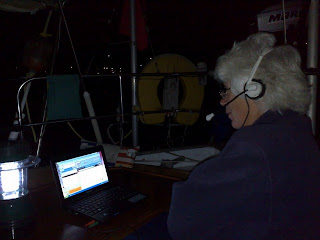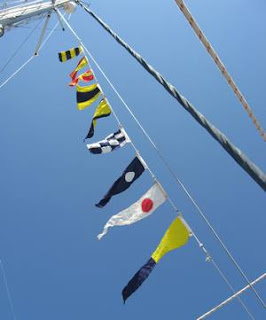One of the first things you see if you get off the ferry here is a signpost to the monument to the Italians killed here. It is the largest of the Greek Ionian Islands and home to Mount Enos - at 1628m - it is one of the highest mountains in Greece.

In common with the other Ionian islands Kefalonia straddles a major fault line and is subject to earthquakes. The last big one in 1953 levelled 80% of the buildings on the island, but as it occurred on a summer afternoon most people were outdoors, thus the death toll was mercifully lower than it might otherwise have been.

We sailed from Ithaca and arrived at Kefalonia's east coast port of Sami. Kefalonia is a very green island, but sailing down the coast we noticed (in amongst healthy trees) large swathes of forest had simply died. Later we learned that earthquakes often change the course of the underground water table and where there was once water, it suddenly no longer exists. We saw the ruins of ancient villages that had to move for this same reason.
Our destination on Kefalonia was the ancient port of Sami - It is now the main gateway from the Greek mainland and other islands to Kefalonia and thus is a port busy with ferry traffic.

As we arrived midday we were able to find a berth on the concrete hammerhead pontoon in the small harbour. The following day Cathy and I hired a motor scooter and headed off to see the sights.

Our first stop was the Melissani Underground Lake with its crystal clear water - several hundred feet deep.

Thousands of years ago this used to be an underground cavern. The roof collapsed and now allows the sun in to illuminate the crystal clear water inside the cavern. It is possible to take a boat ride into the lake. The water is brackish but using chemical dyes they have determined that the water travels from the far side of Kefalonia and across the island through a network of caves like this one and out to the sea.

In the evening we went ashore to a taverna and watched the World Cup, "England vs. USA" match on TV. We are not terribly into football - but what an awful match! Bad show England! The best part of the evening was the cold beer and snacks.

The following day we hit the road and headed for Argostoli, about 24km on the other side of the island - not very far, but there is a mountain range in between! There are two things Cathy doesn't like: Strong wind and heights. Kefalonia has both!

We set out in the morning and as we started up the mountain side through the valley we had what could only be described as a "bug storm" - it seemed every living insect on the island was in the air and smacked into us as we ascended the mountain bends.
Q: How can you tell a happy motor cyclist?
A: By the bugs on his teeth!
[Cathy did not think this was funny either!]
As we ascended we had to avoid falling rocks and goats on the road. When we negotiated the switchback hairpin curves - I thought it sounded as something was wrong with the brakes until I realised it was Cathy gasping when we went around the corners! (Hey, she is the bravest woman I know - and I can't think of anyone I would rather be with - in a storm, 300 miles off shore!). Anyway, we made it over the top, down the other side and into Argostoli.
We took the shortcut into town via the Drepano Causeway (below) - originally built of wood and stone. We stopped to say hello to the swans, who no doubt thought they were going to get fed.

There was a very interesting Archeological Museum of finds showing Mycenean and Stone Age remains. There were some amazing detailed Roman busts like the one below that indicated there were important people and skilled artists living in Kefalonia under the Romans occupation.

On the way back across the central mountain range we stopped off at the Robola Winery that is near Ayios Yerasimos under the shadow of Mount Enos.


We were treated to a tour by the manager of the Robola Winery followed by a tasting of all the wines! Robola grapes produce only white wine, which has a delicious lemony taste. Needless to say the scooter trip back was less frightening.
We learned that the grape plants were grown close to the ground rather than vines on wires - so the grapes provided their own shade and the roots went deep into the soil. (Laura Barclay would have found it very interesting!) - also that earth tremors could alter the water table and kill off an entire field of vines.
Next our whistlestop tour took in what is described as "The Ancient Acropolis of Sami" perched on top of a small mountain to the east of Sami. After negotiating some serious hairpin bends we ended up on a goat track and hiked the rest of the way up the hill. We discovered the ruins of the Ancient Acropolis were truly amazing and well worth risking life and limb on the scooter to get there. There is very little known about the ruins and an archeological excavation is in progress to find out more. The scale of the stones and height of the walls is awesome.
 The views span to both sides of the island. It must have been a very impressive from the sea. Time, battles and earthquakes have now taken their toll.
The views span to both sides of the island. It must have been a very impressive from the sea. Time, battles and earthquakes have now taken their toll.
I am certain this old olive tree growing on the hillside that we saw on the way back down from the Acropolis could tell many stories. We felt a certain rapport to see how old and gnarled it has grown!

From Sami we sailed (motored!) up the Kefalonia Channel to the northen end of the Island to Fiskardo. We moored "bows to" on the new floating pontoon. There was a slight problem in there was an eight foot drop from the front of the boat to get on the pontoon - (solution at the end!).
In Fiskardo we made some interesting discoveries that were not on the tourist map. Behind a building site there was clearly a Roman Forum that had been uncovered during the construction of a block of flats. We happened to spot the dig through a gap in the fence.

Fiskardo has a charming local history museum - most of the displays appeared to have been done by students from the local school. A skeleton of a small whale caught our eye and so did the fact that it was killed by a plastic bag! Whales like turtles eat jellyfish and mistake a floating plastic bag as their favourite food.

Despite temperatures in the mid-30s, we had a hike around the point near Fiskardo and discovered the Venetian light house below. We went inside and climbed the stairs to the top. On the way down we discovered the whole staircase was supported by a bit of stone about 1" wide - So much for Health & Safety in Greece!

On the same walk we found what appeared to be a Norman Church in the scrubland. This is believed to be associated with Robert Guiscard the Norman ruler of Sicily, who also invaded Kefalonia. He’s said to have died of the plague shortly after he arrived!

On the outskirts of Fiskardo we went snorkeling off a small pebble beach. Behind the beach on the hillside was an interesting site of a Roman graveyard and just at the beach they had uncovered a Roman bath house (below).

Note the remains of the hypocaust [under floor heating] - it was fun to think that Romans were using this same beach several thousand years ago - just as we were today.
Finally we cannot leave Kefalonia without showing you my clever wife's solution of how to get off the front of the boat when it is almost eight feet down to the pontoon! 10/10.

Seriously good engineering!















